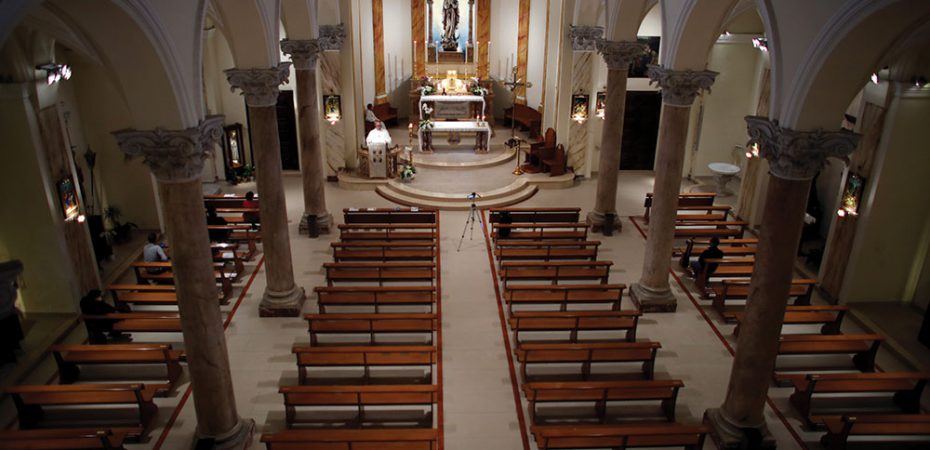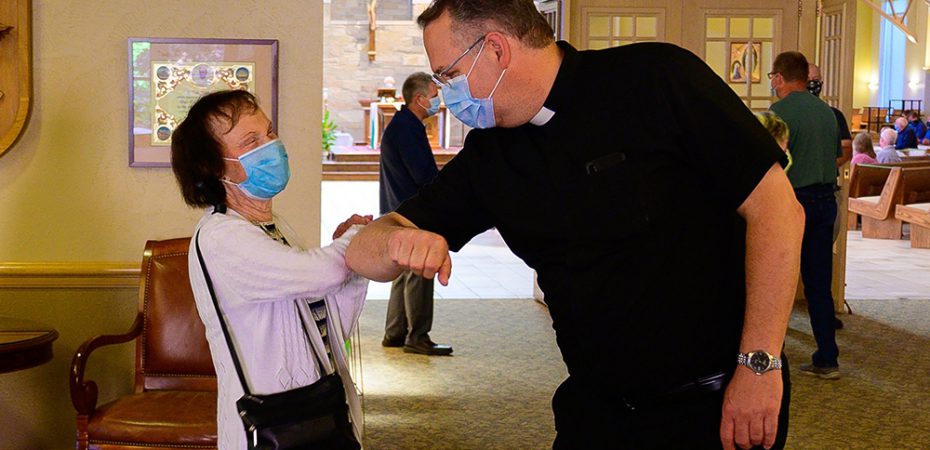Our Desert Path
Meeting God in trials, loneliness and uncertainty
Patricia Sharbaugh Comments Off on Our Desert Path
In the Book of Exodus, the Hebrew people are rescued from slavery in Egypt in a dramatic display of God’s power. But despite this life-changing encounter with God, when they find themselves hungry in the desert, they look back longingly at the “golden age” of slavery, saying, “If only we had died at the LORD’s hand in the land of Egypt, as we sat by our kettles of meat and ate our fill of bread! But you have led us into this wilderness to make this whole assembly die of famine!” (16:3).
This verse illustrates the challenge and promise of the desert. When we try to move from what enslaves us in life toward freedom, we think our choice is between slavery and freedom, but really it is between slavery and uncertainty. We only learn to be free by passing through a period of great uncertainty. In the Bible, the desert is the place of uncertainty, a place of trial, testing and temptation, but also a place of transformational encounter with God. The bleak wilderness of the desert is not the destination in biblical stories, but the way. Passing through the desert is a temporary aspect of faith journeys, yet is powerful, formative influence shapes the identity of all who walk that way.
Jesus’ spirituality is shaped by the desert. He is a follower of John the Baptist, who goes out into the desert and proclaims it the place to prepare the way of God. After his baptism, Jesus is driven into the desert, where he faces a time of trial, testing and temptation. His profound encounter with God in the desert never leaves him, and throughout his ministry he seeks out the desert as a refuge. He teaches crowds in the desert, and then, just as God fed the Israelites manna in the desert, Jesus feeds the hungry crowds who gathered there to hear him teach. For Jesus, the desert is a place of preparation, of challenge, of prayer and rest, of teaching, and of feeding. In the desert, Jesus understood what it meant to be called God’s beloved Son. It was not a call to self-fulfillment or self-realization, but to self-emptying love lived in utter dependence on God.
The desert spirituality of Jesus follows a faith journey repeated throughout the Old Testament. This pattern of trial followed by deep encounter with God begins with Moses, is foundational in the formation of Israel, is repeated in the story of Elijah, spoken about in the prophets, and lived in Israel’s experience of exile and return. The temptations Jesus encounters in the desert — hunger, testing God and idolatry — are the very temptations Israel experienced in the wilderness. We see the pattern so often that we are compelled to ask what it teaches us about faith journeys. Perhaps this pattern is repeated so consistently because there is only one way to move toward God from the tyranny of our own egos and from the tyranny of others, and that way involves walking through lonely places and encountering feelings of desolation and abandonment.
The Desert Within
Eremos is the Greek word translated as desert or wilderness. When eremos refers to a place, it means a place abandoned, empty and desolate. In the plural, the word means lonely places. Loneliness is an ingredient in many experiences of life. All of us are born alone, all of us die alone, and all of us visit many lonely spaces and places along the way. If we are willing to listen closely enough, loneliness offers us many gifts.
The most important is an awareness of the deep chasm of emptiness that lies within us, an abyss we cannot fill, that urges us to reach beyond ourselves, to cry out to God, to pray. Loneliness tells the truth about the basic poverty inherent in the human condition. In “Spirituality and the Desert Experience,” Trappist Father Charles Cummings explores the wilderness within each of us: “The desert is there, inside us, to challenge our sense of belonging entirely to any place or any human person. We can belong to a place and a person but not entirely. We can put down roots but not permanently, because the desert within reminds us that this is not our permanent place.”

Experiences of loneliness awaken us to the truth that we are not fully our own, that we come from God and will return to God, that any certainty or stability we find in this world are only temporary. Lent begins with this recognition. As ashes are placed on our foreheads in the form of a cross, we are told, “Remember that you are dust and to dust you shall return.” Lent tells us the truth about our human condition. During Lent we experience for ourselves the desert spirituality Jesus lived, and, like Jesus, we recognize that the purpose of our life does not lie in self-fulfillment or self-realization, but in utter dependence on God’s self-emptying love.
Desert Lessons
The desert is a prodigious teacher. In fact, monasticism began with recognition of the profound faith lessons offered by the inhospitable climate of the desert. Learning from the desert is not quick or easily rewarding, but the lessons learned there are transformational, even though they are never mastered. Instead, they shape a person by nurturing lifelong practices that open the heart toward an ever-deepening relationship with God. Solitude, encountering the mystery of God and trust are three central themes of desert teaching.
Solitude
Jesuit priest and theologian Karl Rahner’s first published book was a book of prayers called “Encounters with Silence.” In a prayer he calls “God of My Life,” Rahner writes, “Why have you kindled in me the flame of faith, this dark light which lures us out of the bright security of our little huts into your night?” Rahner recognizes that we all construct ways to make us feel secure in the world. This is natural and appropriate, yet God asks us to listen very deeply to the deepest desire of our hearts, which often asks us to leave behind security and venture forth into the unknown where we might encounter God more deeply. This call to venture forth is the call of the desert.
The desert is empty and desolate. There is nothing there. It is in that nothingness that we are stripped of distraction, self-importance and self-control. In the desert we come face-to-face with ourselves. The challenge to face our fears, our anxieties, our fragility, our incompleteness, our wounds and our hunger is one from which we often flee. Those who walk faithfully into the desert learn that the journey from loneliness to solitude is made through prayer. We learn solitude when we become aware that we are not complete without God. Our deepest identity “is hidden with Christ in God” (Col 3:3). We don’t possess this identity but lean into it as we live with and through God in prayer. Facing the truth of the poverty of our humanity shapes us to nurture prayer as a way of life, as the way we carry solitude with us into all our experiences of life.
The Mystery of God
Several encounters with God on Mount Sinai in the desert reveal the transcendent mystery of God. Moses encounters God in a burning bush (cf. Ex 3-4). Fire is a potent symbol for God, capturing the feelings of both fear and fascination an encounter with God provokes. After working with God to free the Hebrew people from slavery, Moses climbs the same mountain where he encountered God in a burning bush and disappears into a dense cloud (Ex 24:18). This cloud provides us with another way to think about encountering the mystery of God. From a distance a dense cloud is visibly distinct; as one draws near, it is less easily seen but more forcefully felt. The cloud changes from an object seen at a distance to the atmosphere through which one sees. This symbol for God emphasizes both the incomprehensibility of God and the mystery of drawing close to God.
The people of Israel also encounter God on Mount Sinai in the desert, an encounter described using the most powerful storm imagery available. There is thunder, lightning, smoke, shaking and a very loud blast of sound. Later the prophet Elijah encounters God on that same desert mountain, though he doesn’t find God in the wind, earthquake or fire, but in “a light silent sound” (1 Kgs 19:12).
These different encounters in the very same place show us that experiencing divine mystery in the desert is very personal. No one symbol can capture the transcendent mystery of God, and every person, every community, experiences God in diverse and personal ways. Elijah teaches us that deepening our relationship with God requires faithfulness amid hardship, discernment and deep listening. We must carefully attend to God’s mystery unfolding amid our lives in deeply personal ways.
Trust
The desert is not only a place of trial followed by encounter with divine mystery, but also the place where God heals, renews and feeds us. After the people of Israel are freed from slavery, but before they meet God on Mount Sinai, they must pass through the desert. The desert teaches them what it means to live in complete dependence on God. In this time of uncertainty between slavery and freedom, God feeds them manna (cf. Ex 16). Practical rules are provided for collecting manna, and underlying these rules are lessons about walking with God through life. A relationship with God involves trusting God every day to provide what is needed for that day. It involves a worshipping community where the blessings of God flow to every member of that community. Most importantly, God can be trusted to meet us in the hard stretches of life and give us all that we need.
The prophet Isaiah, speaking to the downtrodden, defeated people of Israel who are living in exilic wilderness, holds out hope for renewal by envisioning a transformation of the desert (cf. Is 35). Isaiah’s transformational vision of the desert includes flowers blooming, pools of water for quenching thirst, the absence of all dangerous predators, and healing of the blind, the deaf, the lame and the mute. All this occurs so that the faithful can participate in a joyous celebratory walk through the desert to the city of God. Isaiah’s vision feeds the desire of St. John the Baptist, driving him into the wilderness to prepare for God’s way. Jesus’ healings of the blind, the deaf, the lame and the mute tell us that he is the source of God’s renewal, and the presence of God’s love in every wilderness we encounter.
The Desert in Our Lives
Even if we don’t willingly walk into the desert, desert experiences find us as we walk through life. Unasked-for desert experiences are visited upon people unexpectedly in the form of illness, accidents, unemployment or the death of a loved one. Small wildernesses are woven through life and can be seen in the isolation of caring for small children, the necessary loneliness that accompanies some professions, or the wilderness of a long illness or a hospital stay. This list of wildernesses is far from comprehensive. Many situations in life move us to places of uncertainty that challenge our understanding of ourselves and what life demands of us. Though stark, lonely and empty, these desert moments deepen our spiritual lives.
Lent is our opportunity to learn the ways of God in the desert. Willingly entering the desert helps us to nurture lifelong practices that draw us near to God and sustain us when we encounter unchosen deserts in our lives. During Lent we try to recognize the things that enslave us and leave them behind, journeying into unknown places with trust that God will meet us there, give us all that we need, and lead us to gardens of renewed hope. During Lent we nurture the practices that open our hearts to the transformative love of God.
PATRICIA SHARBAUGH, Ph.D., is associate professor of theology at Saint Vincent College in Latrobe, Pennsylvania. She specializes in the field of biblical theology.





